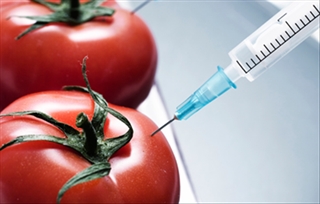
A Genetically Modified Organism (GMO) is the result of a laboratory process of artificially inserting genes into the DNA of food crops or animals is called a genetically modified organism or GMO. The foreign genes may come from bacteria, viruses, insects, animals or even humans. Because this involves the transfer of genes, GMOs are also known as “transgenic” organisms. This process may be called either Genetic Engineering (GE) or Genetic Modification (GM); they are one and the same.
In the 1980s, a contaminated brand of a food supplement called L-tryptophan caused deadly epidemic killed about 100 Americans and caused sickness and disability in another 5,000-10,000 people. The source of contaminants was almost certainly the genetic engineering process used in its production.
(1) The disease took years to find and was almost overlooked. It was only identified because the symptoms were unique, acute, and fast-acting. If all three characteristics were not in place, the deadly GM supplement might never have been identified or removed. In 1992, the Food and Drug Administration claimed they had no information showing that GM foods were substantially different from conventionally grown foods. Therefore they are safe to eat, and absolutely no safety studies were required. But internal memos made public by a lawsuit reveal that their position was staged by political appointees who were under orders from the White House to promote GMOs. In addition, the FDA official in charge of creating this policy was Michael Taylor, the former attorney for Monsanto, the largest biotech company,and later their vice president.
If GM foods on the market are causing common diseases or if their effects appear only after long-term exposure, we may not be able to identify the source of the problem for decades, if at all. There is no monitoring of GMO-related illnesses and no long-term animal studies. Heavily invested biotech corporations are gambling with the health of our nation for their profit. When the tipping point of consumer concern about GMOs was achieved in Europe in 1999, within a single week virtually all major food manufacturers committed to remove GM ingredients. The Campaign for Healthier Eating in America is designed to reach a similar tipping point in the US soon. Most Americans say they would not eat GMOs if labeled, but unlike most other industrialized countries, the U.S. does not require labeling.
In 2009, the American Academy of Environmental Medicine (AAEM) stated that, “Several animal studies indicate serious health risks associated with genetically modified (GM) food,” including infertility, immune problems, accelerated aging, faulty insulin regulation, and changes in major organs and the gastrointestinal system. The AAEM has asked physicians to advise all patients to avoid GM foods.
(2) Unlike safety evaluations for drugs, there are no human clinical trials of GM foods. The only published human feeding experiment revealed that the genetic material inserted into GM soy transfers into bacteria living inside our intestines and continues to function.
(3) This means that long after we stop eating GM foods, we may still have their GM proteins produced continuously inside us. Animal studies show that DNA in food can travel into organs throughout the body, even into the fetus.

The biotech industry claims that Bt-toxin is harmless to humans and mammals because the natural bacteria version has been used as a spray by farmers for years. In reality, hundreds of people exposed to Bt spray had allergic-type symptoms,
(4) and mice fed Bt had powerful immune responses and damaged intestines.
(5) Moreover, the Bt in GM crops is designed to be more toxic than the natural spray and is thousands of times more concentrated.
Farm workers throughout India are getting the same allergic reactions from handling Bt cotton
(6) as those who reacted to Bt spray.
(7) In the Filipinos up to five villages fell sick when a nearby Bt corn variety was pollinating.
(8)Thousands of animals and livestock in America, India, and Europe died after grazing on Bt cotton plants after harvest. Others suffered poor health and reproductive problems.
(9)(10) No tests can guarantee that a GMO will not cause allergies. Although the World Health Organization recommends a screening protocol,
(11) the GM soy, corn, and papaya in our food supply fail those tests—because their GM proteins have properties of known allergens.
(12)
There is growing evidence of harm from GMOs. GM soy and allergic reactions. Soy allergies skyrocketed by 50% in the UK, soon after GM soy was introduced. A skin prick allergy test shows that some people react to GM soy, but not to wild natural soy.
(13) Cooked GM soy contains as much as 7-times the amount of a known soy allergen.
(14) GM soy also contains a new unexpected allergen, not found in wild natural soy.
(15)
In reality, FDA scientists had repeatedly warned that GM foods can create unpredictable, hard-to-detect side effects, including allergies, toxins, new diseases, and nutritional problems. They urged long-term safety studies, but were ignored.
(16) Today, the same biotech companies who have been found guilty of hiding toxic effects of their chemical products, and are in charge of determining whether their GM foods are safe.
(17) Industry-funded GMO safety studies are too superficial to find most of the potential dangers, and their voluntary consultations with the FDA are widely criticized as a meaningless façade.
(18)
Jeffrey M. Smith is the author of publication Genetic Roulette: The Documented Health Risks of Genetically Engineered Foods, which presents 65 risks in easy-to-read two-page spreads. His first book, Seeds of Deception, is the top rated and #1 selling book on GM foods in the world. He is the Executive Director of the Institute for Responsible Technology.
www.responsibletechnology.org, which is spearheading the Campaign for Healthier Eating in America. Go to
www.seedsofdeception.com to learn more about how to avoid GM foods.